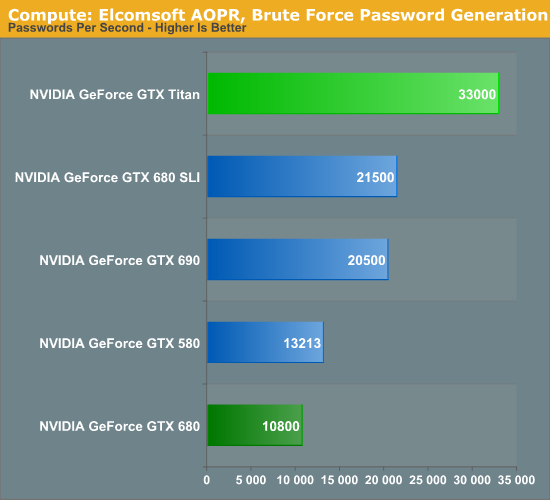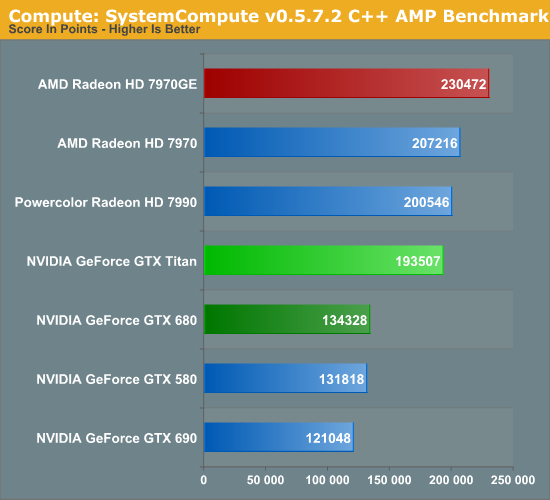NVIDIA’s GeForce GTX Titan Review, Part 2: Titan's Performance Unveiled
by Ryan Smith & Rahul Garg on February 21, 2013 9:00 AM ESTTitan’s Compute Performance, Cont
With Rahul having covered the basis of Titan’s strong compute performance, let’s shift gears a bit and take a look at real world usage.
On top of Rahul’s work with Titan, as part of our 2013 GPU benchmark suite we put together a larger number of compute benchmarks to try to cover real world usage, including the old standards of gaming usage (Civilization V) and ray tracing (LuxMark), along with several new tests. Unfortunately that got cut short when we discovered that OpenCL support is currently broken in the press drivers, which prevents us from using several of our tests. We still have our CUDA and DirectCompute benchmarks to look at, but a full look at Titan’s compute performance on our 2013 GPU benchmark suite will have to wait for another day.
For their part, NVIDIA of course already has OpenCL working on GK110 with Tesla. The issue is that somewhere between that and bringing up GK110 for Titan by integrating it into NVIDIA’s mainline GeForce drivers – specifically the new R314 branch – OpenCL support was broken. As a result we expect this will be fixed in short order, but it’s not something NVIDIA checked for ahead of the press launch of Titan, and it’s not something they could fix in time for today’s article.
Unfortunately this means that comparisons with Tahiti will be few and far between for now. Most significant cross-platform compute programs are OpenCL based rather than DirectCompute, so short of games and a couple other cases such as Ian’s C++ AMP benchmark, we don’t have too many cross-platform benchmarks to look at. With that out of the way, let’s dive into our condensed collection of compute benchmarks.
We’ll once more start with our DirectCompute game example, Civilization V, which uses DirectCompute to decompress textures on the fly. Civ V includes a sub-benchmark that exclusively tests the speed of their texture decompression algorithm by repeatedly decompressing the textures required for one of the game’s leader scenes. While DirectCompute is used in many games, this is one of the only games with a benchmark that can isolate the use of DirectCompute and its resulting performance.
Note that for 2013 we have changed the benchmark a bit, moving from using a single leader to using all of the leaders. As a result the reported numbers are higher, but they’re also not going to be comparable with this benchmark’s use from our 2012 datasets.

With Civilization V having launched in 2010, graphics cards have become significantly more powerful since then, far outpacing growth in the CPUs that feed them. As a result we’ve rather quickly drifted from being GPU bottlenecked to being CPU bottlenecked, as we see both in our Civ V game benchmarks and our DirectCompute benchmarks. For high-end GPUs the performance difference is rather minor; the gap between GTX 680 and Titan for example is 45fps, or just less than 10%. Still, it’s at least enough to get Titan past the 7970GE in this case.
Our second test is one of our new tests, utilizing Elcomsoft’s Advanced Office Password Recovery utility to take a look at GPU password generation. AOPR has separate CUDA and OpenCL kernels for NVIDIA and AMD cards respectively, which means it doesn’t follow the same code path on all GPUs but it is using an optimal path for each GPU it can handle. Unfortunately we’re having trouble getting it to recognize AMD 7900 series cards in this build, so we only have CUDA cards for the time being.

Password generation and other forms of brute force crypto is an area where the GTX 680 is particularly weak, thanks to the various compute aspects that have been stripped out in the name of efficiency. As a result it ends up below even the GTX 580 in these benchmarks, never mind AMD’s GCN cards. But with Titan/GK110 offering NVIDIA’s full compute performance, it rips through this task. In fact it more than doubles performance from both the GTX 680 and the GTX 580, indicating that the huge performance gains we’re seeing are coming from not just the additional function units, but from architectural optimizations and new instructions that improve overall efficiency and reduce the number of cycles needed to complete work on a password.
Altogether at 33K passwords/second Titan is not just faster than GTX 680, but it’s faster than GTX 690 and GTX 680 SLI, making this a test where one big GPU (and its full compute performance) is better than two smaller GPUs. It will be interesting to see where the 7970 GHz Edition and other Tahiti cards place in this test once we can get them up and running.
Our final test in our abbreviated compute benchmark suite is our very own Dr. Ian Cutress’s SystemCompute benchmark, which is a collection of several different fundamental compute algorithms. Rahul went into greater detail on this back in his look at Titan’s compute performance, but I wanted to go over it again quickly with the full lineup of cards we’ve tested.

Surprisingly, for all of its performance gains relative to GTX 680, Titan still falls notably behind the 7970GE here. Given Titan’s theoretical performance and the fundamental nature of this test we would have expected it to do better. But without additional cross-platform tests it’s hard to say whether this is something where AMD’s GCN architecture continues to shine over Kepler, or if perhaps it’s a weakness in NVIDIA’s current DirectCompute implementation for GK110. Time will tell on this one, but in the meantime this is the first solid sign that Tahiti may be more of a match for GK110 than it’s typically given credit for.










337 Comments
View All Comments
chizow - Saturday, February 23, 2013 - link
The usage is fine, as it's in reference to Nvidia's practice of overcharging it's customers with exorbitant price increases. That's usury.The "entitlement" comes from helping to build Nvidia from a rinky dink GPU company into the global factor it is today by spending a few thousand dollars every few years on their glorified gaming machines.
The outrage comes from that company thinking it's OK to suddenly up the ante and charge you 2x as much for the same class and level of performance you'd expect from what you've paid every few years in an upgrade.
It's obvious you've never bought into this market before, because you'd feel more invested in what has happened in the landscape of desktop GPUs since the 7970 launch and the rest of Kepler launch and understand what is happening here. I don't plan to buy it as most others I know who have bought in this range of GPU before, most of whom have similar sense of disappointment and disdain for Nvidia's Titan pricing strategy.
As for the last bit...Nvidia has sold their 500+mm^2 ASIC GPUs for much less than even $500 in the past, hell the GTX 285 sold for as low as $330 and even the past GPUs with reported "terrible" yields like the GT200 and GF100 were sold for $500 in quarters where Nvidia still turned a profit. TSMC is charging slightly more per 300mm wafer at 28nm than previous nodes, but nothing close to the 100% premium being asked for with TITAN. So obviously they could sell it for less and still profit, they just chose not to.
CeriseCogburn - Saturday, February 23, 2013 - link
You're an IDIOT.nVidia sells these for THOUSANDS EACH, and production is LIMITED, you idiot gasbag fool.
The fact that they spare a few dies for a grand shows they are being extremely generous with their profit potential and giving you sick ungrateful whining losers a big freaking break !
But you're FAR TOO STUPID to know that. That's why nVidia has a REAL CEO and you're a crybaby whiner FOOL on the internet, who cannot think past his own insane $360 card budget, AND GETS IT 100% INCORRECT.
When nVidia sells one of these limited production monsters to one of you whining ungrateful OWS crybaby losers for a $1000.00, they are LOSING A COUPLE GRAND IN PROFITS, YOU IDIOT !
Have a nice, dumbed down, idiot crybaby loser day.
chizow - Saturday, February 23, 2013 - link
Production isn't limited, Nvidia and the article have shot that down from the outset, so please stop trying to use that as some "limited" production excuse.Nvidia will make as many of these as demand dictates, but they could've just as easily charged $300-400 less and sold untold magnitudes more GK110-based cards. That's the general impression I'm getting from all over the internet and from the circles of enthusiast I've encountered, anyways.
Pricing these at $1K is like stealing candy from a retarded kid (you), but $600-$700 would be justified based on expected price and performance relative to previous generations and worth a look at 1 or even 2 for any enthusiast who purchased in the enthusiast range before and still allowed Nvidia to charge a premium for Kepler's overachieving performance numbers.
CeriseCogburn - Sunday, February 24, 2013 - link
No, they shot down the only 10,000 amd fanboy liar rumor, and claimed there will be "continuing availability".So you're a liar and a fool.
chizow - Sunday, February 24, 2013 - link
Exactly, you said these were "limited" when they are not, so you stand corrected.Looks like you're the liar and the fool, but why state the obvious?
CeriseCogburn - Sunday, February 24, 2013 - link
They are limited, production is NOT limitless, a gradeB skumbag fool who needs a clue from a real authority to use common sense (to paraphrase your prior stupid remark) would know that.nVidia CANNOT produce whatever demand is whenever demand goes over production capacity, and the price you want, you have implied it would.
So go blow it out your tinfoil hat.
chizow - Monday, February 25, 2013 - link
Production is limited by demand with GK110, not some artificial "limited" production warranting the $1K price tag as you implied. But why state the obvious about the law of supply and demand?Please stop trying to cover your tracks with dishonesty, you were wrong to say Titan is limited when it was not, now move along.
CeriseCogburn - Tuesday, February 26, 2013 - link
Moving along would be you checking production capacity and the dates in question, of course instead you've gourd bolted reynolds wrap.CeriseCogburn - Saturday, February 23, 2013 - link
Yes mlambert908, they are spoiled lying crybaby children.Thanks for being another sane voice in the wilderness.
The crybabies need to become men and earn a living, so they stop embarrassing themselves. Not that they know or understand that, nor that they ever will, but it gets sickeningly redundant when they poo their diapers all over the place every time.
How about they grow up, get to work, and buy a video card once without whining like spoiled brats for months on end over the evil overlords who just won't give them a huge break because... they demand it.
Maybe the Illegal Usurper will start enforcing price controls for them in this crappy economic worldwide situation where ALL prices have been rising greatly for a number of years.
Perhaps the fantasy world the brat fanboy crybabies live in is actually a sheltered virtual unreality absolutely separate from RL.
Charlie D's slaves, with deranged fantasy brains, and like you said, one of the sickest cases of entitlement the world has ever seen.
chizow - Saturday, February 23, 2013 - link
It's funny that you keep mentioning Charlie D., your asinine rants make him look like a genius and a prophet.